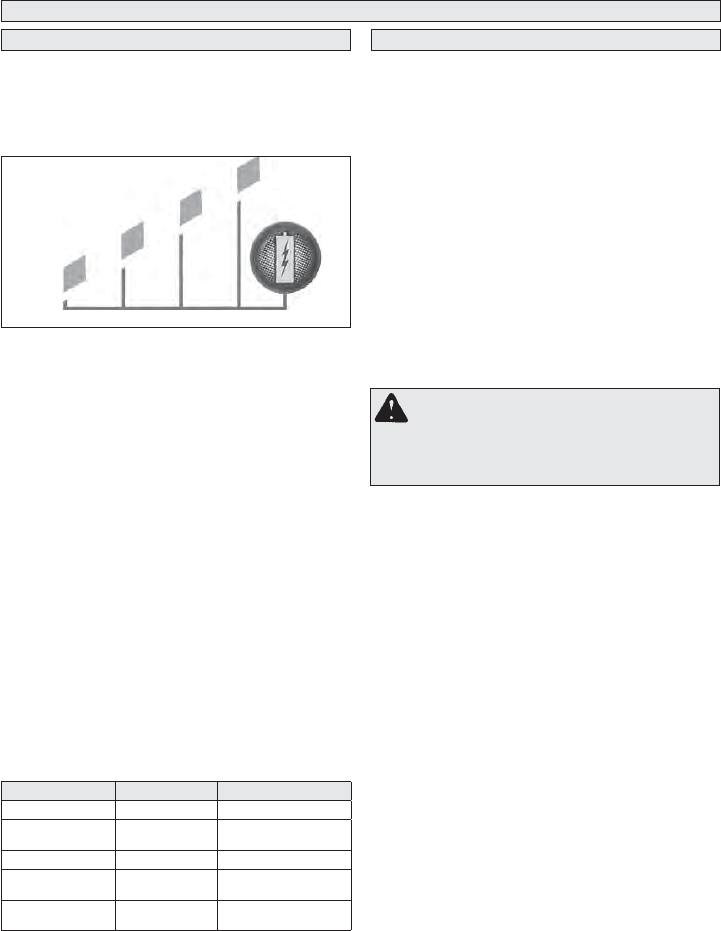
4
Fuel Gauge
Use the Fuel Gauge to determine the battery pack's
remaining run time. Press the Fuel Gauge button to
display the lights. The Fuel Gauge will light up for
2-3 seconds. When less than 10% of charge is left,
1 light on the fuel gauge will slowly. flash
MILWAUKEE LITHIUM-ION BATTERY PACKS
78-100%
55-77%
33-54%
10-32%
Less than 10% if bottom light is fl ashing
Approximate Run
Time Remaining
NOTE: If the Fuel Gauge doesn't appear to be
working, place the battery pack on the charger and
charge as needed.
Compared to NiCd battery pack types
Lithium-Ion battery packs deliver fade-free power
for their entire run time. The tool will not experience
a slow, gradual loss of power as you work. To signal
the end of discharge, 1 light on the fuel gauge will
quickly for 2-3 seconds and the tool will not
run. Charge the battery pack.
NOTE: Immediately after using the battery pack,
the Fuel Gauge may display a lower charge than
it will if checked a few minutes later The battery .
cells "recover" some of their charge after resting.
Battery Pack Protection
To protect itself from damage and extend its life, the
battery pack’s intelligent circuit monitors current draw
and temperature. In extremely high torque, binding,
stalling, and short circuit situations, the battery pack
will turn OFF the tool if the current draw becomes
too high. All the fuel gauge lights Release
the trigger and restart.
Under extreme circumstances, the internal tem-
perature of the battery could become too high. If
this happens, the fuel gauge lights will in an
alternating pattern and the tool will not run. Allow
the battery to cool down.
Maintenance and Storage
Do not expose your battery pack or cordless tools
to water or rain, or allow them to get
damage the tool and battery pack. Do not use oil
or solvents to clean or lubricate your battery pack.
The plastic casing will become brittle and crack,
causing a risk of injury.
Store battery packs at room temperature away from
moisture. Do not store in damp locations where cor-
rosion of terminals may
pack types, permanent capacity loss can result if
the pack is stored for long periods of time at high
temperatures (65°C). MILWAUKEE Lithium-
Ion battery packs maintain their charge during
storage longer than other battery pack types. After
about a year of storage, charge the pack as normal.
Disposing of MILWAUKEE Li-Ion Battery Packs
MILWAUKEE Lithium-Ion battery packs are more
environmentally friendly than some other types of
power tool battery packs (e.g., nickel-cadmium).
Always dispose of your battery pack according to
federal, state and local regulations. Contact a re-
cycling agency in your area for recycling locations.
Even discharged battery packs contain some
energy. Before disposing, use electrical tape to
cover the terminals to prevent the battery pack from
shorting, which could cause a or explosion.fire
WARNING To reduce the risk of injury
or explosion, never burn or incinerate a
battery pack even if it is damaged, dead or
completely discharged. When burned, toxic
fumes and materials are created.
occur.. As with other battery
wet. This could
will flash.
, MILWAUKEE
Fuel Gauge Lights Diagnosis Solution
Lights 1 - 4 Solid Remaining run time Continue working
1 Light, fl ashing slowly Less than 10% run
time left
Prepare to charge pack
1 Light, fl ashing quickly End of discharge Charge pack
Lights 1-4, fl ashing
quickly
Current draw too high Release trigger and restart,
reduce pressure
Lights 1&3 / 2&4,
fl ashing alternatingly
Battery temperature
too high
Release trigger and allow
battery to cool
18 V
Cold Weather Operation
MILWAUKEE M18 LITHIUM-ION battery packs can
be used in temperatures down to . When the
battery pack is very cold, put the battery pack on
a tool and use the tool in a light application. It may
“buzz” for a short time until it warms up. When the
buzzing stops, use the tool normally.
0°C
12V AND 18 V
flash
flash
Do not keep topping up the battery without using
the battery pack. Run down to 50% (2 lights) at
least every six (6) months.








